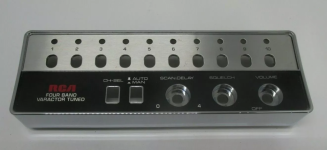In 1979 I started to work as a police and fire dispatcher for a local police department. At the same time I was a Paid On Call firefighter and later a Medic for a different town. I met a dispatcher (Dan) from a neighboring fire department as our towns had auto-aid agreements and a hotline between us.
Dan introduced me to some more esoteric scanning stuff and he and I put together a rather extensive list of frequencies used by the 4 counties in our area. Dan was really into listening to L.A. County FD on low band skip and his radio of choice at the time was an RCA 16S400. He had this on his desk at the FD whenever he was working and when he was talking on the radio it was common to hear the distinctive LACoFD dispatches in the background.
The 16S400 was a 10-channel VHF Low, VHF High and UHF crystal scanner, or as RCA called it, a “Scan-Aire”. I don’t know how they came up with the model number, but I know they had an older 8-channel radio that was otherwise similar called the 16S300. I suppose that 16S indicated scanners and the 300 or 400 were sequential models in that line.
I coveted this radio immensely and tried several times to pry it away from him. By then I was using a BC210 programmable scanner but the RCA ran rings around it on low-band. I also had a pair of RCA ACT-R20/6’s (see that Scanner Tale). I tried to find an RCA for myself but they were not to be found. Apparently RCA dumped the scanner line by the time I discovered the 16S400 and those that had them would not sell. I scoured stores, hamfests and the grapevine with no luck in these pre-Internet days.
Eventually Dan got sick of my whining and traded the RCA to me for something or another, I can’t remember what. I was in hog heaven! I hooked it up the to CB antenna on the roof of City Hall when I was working and listened to low band stuff all night long.
Other than the fantastic performance on low band there were a few other things that made this such a desirable radio. First off it was built like a tank. This thing had a steel case that would fit right in on an Army combat vehicle. I loaned it to the fire department ladder truck guys one day when they needed a wheel chock. It was almost indestructible. Dan had covered the metal case with a rubber flooring product that made it even more durable and hid all the scratches as well. The radio looked modern, even today it would fit right in and one wouldn’t realize it was half a century old. There is something timeless about a black and chrome aesthetic.
This scanner was easy to set up, one could put any frequency's crystal in any position. Each crystal socket had a 3-position slide switch that you would position for the band range (VHF-low, High or UHF) so there was no messing around with jumpers. There was a door on the top of the case for access to the crystal bay so you did not have to take the case apart to get at them. It did have separate UHF and VHF antenna ports but I rarely used it for UHF so I just connected the VHF antenna. The volume and squelch were standard rotary potentiometers and never seemed to go bad, unlike the Regency and Bearcats of the day. It also never seemed to suffer from bad capacitors or cold solder joints like other scanners, it was just well built all the way around. Oddly the RCA scanner used Motorola connectors for the antenna, while the Plectrons that I had then (as a firefighter) had RCA jacks for the antenna.
Over the next few years that old RCA scanner would be traded back and forth between Dan and I several times and I think our mutual friend Scott had it for a while also. As far as I know Dan still has it, the last time I saw it was at his house about 20 years ago and it was still picking up low-band like gangbusters. As much as I liked that radio programmable scanners were the wave of the future and I got rid of all my crystal scanners. We had no idea the type of technology we would have 4 decades later.
I don’t know why RCA didn’t make a larger showing in the scanner market but they did a great job with this rig. I would have liked to see what else they would have come up with. I suspect however that this was actually built by a jobber in Japan and do seem to recall seeing similar models under a different name someplace. At the time RCA had a decent slice of the two-way radio market, not nearly as big as Motorola and GE but they had some decent low-end radios. They had a Special Products Division that sold various consumer electronics like AM/FM radios, tape decks and the like. I suspect that scanners fell under that umbrella rather than the Land Mobile Division (or whatever they called it then).
I think about that radio now and then and pine for the days when Low band was still common and skip was in. I suspect we will be saying that one of these days about High band.
Dan introduced me to some more esoteric scanning stuff and he and I put together a rather extensive list of frequencies used by the 4 counties in our area. Dan was really into listening to L.A. County FD on low band skip and his radio of choice at the time was an RCA 16S400. He had this on his desk at the FD whenever he was working and when he was talking on the radio it was common to hear the distinctive LACoFD dispatches in the background.
The 16S400 was a 10-channel VHF Low, VHF High and UHF crystal scanner, or as RCA called it, a “Scan-Aire”. I don’t know how they came up with the model number, but I know they had an older 8-channel radio that was otherwise similar called the 16S300. I suppose that 16S indicated scanners and the 300 or 400 were sequential models in that line.
I coveted this radio immensely and tried several times to pry it away from him. By then I was using a BC210 programmable scanner but the RCA ran rings around it on low-band. I also had a pair of RCA ACT-R20/6’s (see that Scanner Tale). I tried to find an RCA for myself but they were not to be found. Apparently RCA dumped the scanner line by the time I discovered the 16S400 and those that had them would not sell. I scoured stores, hamfests and the grapevine with no luck in these pre-Internet days.
Eventually Dan got sick of my whining and traded the RCA to me for something or another, I can’t remember what. I was in hog heaven! I hooked it up the to CB antenna on the roof of City Hall when I was working and listened to low band stuff all night long.
Other than the fantastic performance on low band there were a few other things that made this such a desirable radio. First off it was built like a tank. This thing had a steel case that would fit right in on an Army combat vehicle. I loaned it to the fire department ladder truck guys one day when they needed a wheel chock. It was almost indestructible. Dan had covered the metal case with a rubber flooring product that made it even more durable and hid all the scratches as well. The radio looked modern, even today it would fit right in and one wouldn’t realize it was half a century old. There is something timeless about a black and chrome aesthetic.
This scanner was easy to set up, one could put any frequency's crystal in any position. Each crystal socket had a 3-position slide switch that you would position for the band range (VHF-low, High or UHF) so there was no messing around with jumpers. There was a door on the top of the case for access to the crystal bay so you did not have to take the case apart to get at them. It did have separate UHF and VHF antenna ports but I rarely used it for UHF so I just connected the VHF antenna. The volume and squelch were standard rotary potentiometers and never seemed to go bad, unlike the Regency and Bearcats of the day. It also never seemed to suffer from bad capacitors or cold solder joints like other scanners, it was just well built all the way around. Oddly the RCA scanner used Motorola connectors for the antenna, while the Plectrons that I had then (as a firefighter) had RCA jacks for the antenna.
Over the next few years that old RCA scanner would be traded back and forth between Dan and I several times and I think our mutual friend Scott had it for a while also. As far as I know Dan still has it, the last time I saw it was at his house about 20 years ago and it was still picking up low-band like gangbusters. As much as I liked that radio programmable scanners were the wave of the future and I got rid of all my crystal scanners. We had no idea the type of technology we would have 4 decades later.
I don’t know why RCA didn’t make a larger showing in the scanner market but they did a great job with this rig. I would have liked to see what else they would have come up with. I suspect however that this was actually built by a jobber in Japan and do seem to recall seeing similar models under a different name someplace. At the time RCA had a decent slice of the two-way radio market, not nearly as big as Motorola and GE but they had some decent low-end radios. They had a Special Products Division that sold various consumer electronics like AM/FM radios, tape decks and the like. I suspect that scanners fell under that umbrella rather than the Land Mobile Division (or whatever they called it then).
I think about that radio now and then and pine for the days when Low band was still common and skip was in. I suspect we will be saying that one of these days about High band.



